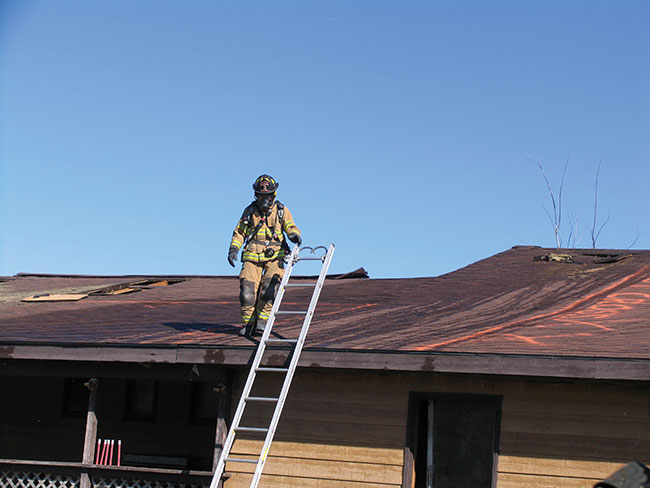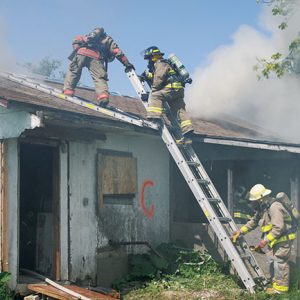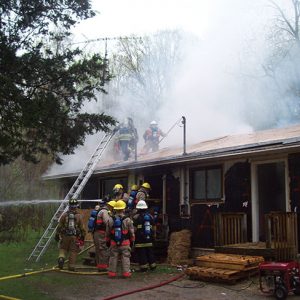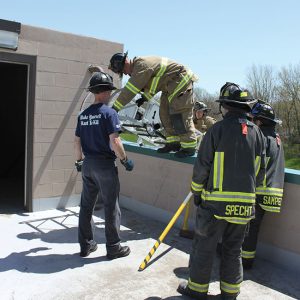
Features
Back to Basics: Ladder Dating — Getting on and off the ladder
March 15, 2021
By
Mark van
 Photo 1:The ground ladder placed with four rungs above the roof line. PHOTO CREDIT: Mark van der Feyst
Photo 1:The ground ladder placed with four rungs above the roof line. PHOTO CREDIT: Mark van der Feyst Last edition we looked at working on the ground ladder and some of the other options that are available to use in place of the traditional leg lock. For this article, we are going to focus on getting on and off the ladder. Our study so far has been with the ground ladder, but we are going to include the aerial ladder in our topic this time as it’s very applicable to both.
The most common operation with a ground or aerial ladder that involves getting on and off is with ventilation or gaining access to the roof of a building. Firefighters have fallen off the roof of a building when transitioning from the ladder to the roof. On Oct. 15, 2018, an FDNY firefighter was seriously injured when he fell 30 feet after he lost his footing when getting onto the roof from the ladder. In April 2017, another FDNY firefighter fell when he was going from the roof to the aerial platform. In this situation, the aerial ladder jerked suddenly right before he was getting on, causing him to lose his balance and fall five stories to his death.
So, let’s start with the ground ladder as it is raised to the roof for roof operations. In basic training we are taught to raise the ground ladder so there is between three to five rungs above the roof line. This is done to make it easier for the firefighter to get on and off the roof, as well as make it visible to know where the ladder is. In Photo 1 the ground ladder has four rungs above the roof line. In Photo 2, the ground ladder has six rungs above the roof line. If the ladder was raised with only three rungs showing above the roof line, it reduces the ladder’s profile for the firefighter to grab onto. Notice how the two ladders pictured are providing waist to shoulder height access for the firefighter to place their hands on for control of the ladder and their transition.
When a ground ladder is less than three rungs above the roof line, it forces the firefighter to have to bend down to grab the ladder when transitioning onto it. This is not an ergonomic position to be in when getting onto a ladder. It lends into loss of balance with the bulk of the weight on the firefighter’s upper torso (SCBA and gear) being pulled toward the ground by being bent over. In Photo 3, note how the firefighter is able to stand upright while getting off the ladder because there are four rungs above the roof line.
The other aspect is the pivot point of the ground ladder when there are three to five or more rungs above the roof line. Pivot point is the point on the ground ladder where the ladder can kick out easily when rested against an object. The resting spot will be the roof line and depending upon the height of the ladder rungs above the roof line, the ground ladder can kick out when the weight is counter balanced above the pivot point.
This can occur when the firefighter climbs up the ladder and continues climbing up the ladder above the roof line. In Photo 2, if the firefighter were to keep climbing up the ladder and stand on the fourth or fifth rung from the top, the ladder becomes unstable and the weight of the firefighter will cause a counter balance making it pivot like a teeter totter. This can be avoided by not stepping above the roof line on the rung. Step onto the rung below the roof line when getting back on the ladder like you see in Photo 3.
The angle of the ladder against the building can also assist with the ladder kicking out due to the pivot point. In Photo 4 the ladder angle is a gentle angle, probably around 60 degrees as compared to the traditional 70 to 75 degrees. With the ladder having five rungs above the roof line, the chances of the ladder kicking out are enhanced should the firefighter step onto the rungs above the roof line. What will prevent this is to have a person heel the ladder from below before a firefighter steps onto the ladder from the roof and when the firefighter is going to step onto the roof from the ladder. The key point here is that the heeling firefighter needs to heel the ladder until the firefighter is off or on the ladder. If they leave to soon, the ladder will kick out.
When getting off or on the ladder, the firefighter needs to have and maintain positive control the entire time. This means being aware of your surroundings while at the same time having physical control of both your body and the ladder when getting on or off. In Photo 3, one firefighter has both feet on the roof ladder with one hand on the ground ladder still while the second firefighter has both hands and feet in contact with the ladder and the building.
The same is seen with the aerial ladder. In Photo 5 the firefighter has both hands on the aerial ladder beam and both feet on a solid part of the roof. He is still holding onto the ladder while standing on the roof and will transition onto the roof top in the same manner. When the firefighter goes to get off the roof, the opposite will be done in order to have and maintain positive control. Doing this helps the firefighter to avoid losing their footing or losing their balance.
During the next training session with your crew or station, practice getting off and on the ladder while maintaining positive control. Doing this will increase your skill proficiency and confidence to work with ladders.
Mark van der Feyst has been in the fire service since 1999 and is currently a firefighter with the FGFD. He is an international instructor teaching in Canada, the United States, FDIC and India. He is a local level suppression instructor for the Pennsylvania State Fire Academy and the lead author of Fire Engineering’s Residential Fire Rescue book and other DVDs. He can be contacted at Mark@FireStarTraining.com.
Print this page



